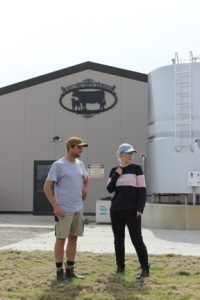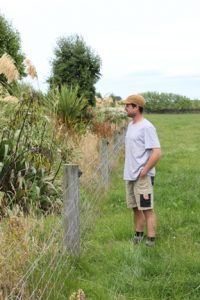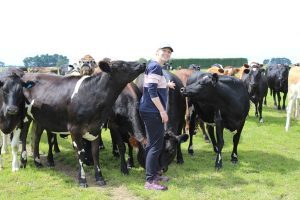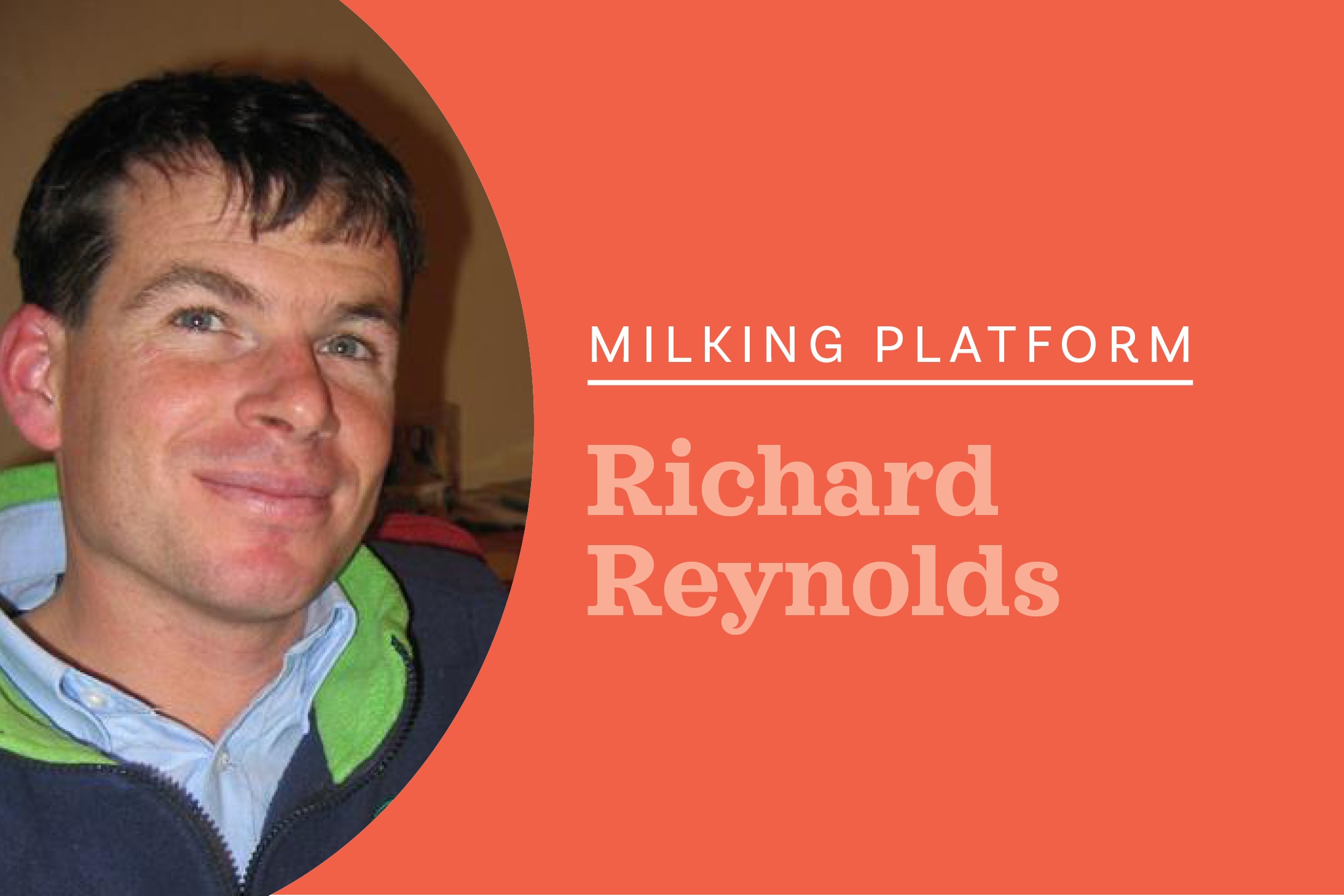Willow Creek Dairies near Woodlands won merit awards for innovation, management, water quality and biodiversity in the Southland 2018 Ballance Farm Environment Awards but for Matt and Sarah McKenzie their pride and joy are their cows. Words and photos: Karen Trebilcock.
When Matt and Sarah McKenzie decided to give dairying a go, Matt and his dad chose a low-input system.
“We almost shook on it,” Matt says.
Now into their fourth season, and after a rough year of trying once-a-day, they’ve decided it’s not for their farm.
“I know once-a-day people say it takes three years to change over and we only gave it one year but that’s all we could do,” he says.
“We were down about 110,000kg MS, and we had to selectively cull about 100 cows based on udder deterioration.
‘By the end of winter, the grass they started on is freshening up so there’s something growing to take up the nutrients, which must be working like a catch-crop.’
“Some of cows, especially the heifers, just dried themselves off and you could see some of the cows were really uncomfortable with full udders.”

Mastitis was also a huge problem.
“Going once-a-day taught us so much. Because of the mastitis we got the shed 100% right – the vacuum, the cups, teat spray, everything is now spot on.
“This season we’ve treated, I think, less than 30 cows so far (compared with 80 plus on once-a-day) and somatic cells are averaging about 80,000.
“And with once-a-day we had fat cows and fat cows are actually not what you want. It causes lots of problems during calving.”
Back on twice-a-day this season, the cows and Matt and Sarah are happy again and although the cows aren’t fat, they’re definitely not skinny.
“I love feeding cows well. We try to keep the weight on them all season so we’re not catching up anywhere. Every day they’re getting fully fed – that’s our aim.
“We want to have their guts touching the bails in the dairy.”
Although the five and a half hectares of summer turnips by the dairy this year might have been a mistake.
“We planted it as insurance, in case it gets dry, but this year we’ve had such a good growing season we don’t really need it.
“The cows go on it at midday and stay there until afternoon milking but they know they’re going to get it so occasionally they’re not eating the paddocks out properly in the mornings.”
Besides this season’s higher inputs and higher production, Willow Creek Dairies stands out in Southland because it winters on grass.
“For animal health it’s the best – there’s no transitioning on to crop and off again at the end of winter,” Matt says.
“Cows have dry ground to lie down on and it’s great to see them resting in the middle of winter content in the paddock.
“There is mud but there is lot less of it than when you’re on crop, there’s less runoff so it’s better environmentally and we don’t have to work paddocks up to plant them and then rework them in the spring. Plus we can keep grazing them through the summer.”
Each spring, the poorer paddocks are identified and designated for wintering. As balage is cut, it’s stacked along the fence lines.
The paddocks are grazed as needed throughout the summer and then the week before drying off are grazed again so covers are low.
The herd is divided into mobs of 75 and each mob given three bales of balage a day and the fence moved three metres.

A backing fence is used as well and there are moveable water troughs.
“They eat the grass down so there’s nothing left but every day they get new ground to lie on.
“And by the end of winter, the grass they started on is freshening up so there’s something growing to take up the nutrients, which must be working like a catch-crop.
“Last year we had a winter paddock with a gully down the middle that runs water when it rains and we fenced it off, with temporary fencing.
“All winter that water stayed clear. There was no sediment in it so what we’re doing works.”
In spring what is left is sprayed off and new pastures planted – recently mixes of grasses, red and white clovers, plantain and chicory.
Even though much of the farm was regressed with the conversion, Matt is not worried about running out of paddocks to renew.
“We’re getting such good results from the new grasses and some of the older ones do need doing again.”
He says he knew more and more Southland farmers who were wintering on grass and his farm consultant Ivan Lines is championing it.
“We’re buying in some of the balage so it does cost a lot but not as much as putting in crop and plus we have the benefits of animal health.”
Sarah says the farm is great at growing grass.
In the first year of the conversion it grew 12 tonnes/ha and now is at 16t/ha, Matt says.
“And we’re hoping that will keep climbing.”
Their stocking rate of three cows per hectare on the 230ha milking platform they think is about right, although they have consents to milk up to 780 cows. However, instead of more cows they want to make more of their own balage and stop buying in silage.
With grain feeding in the dairy, they feed an average of 1.8kg/cow every day of the season.
“It depends a bit on the grass and the weather. If we’ve got lots of grass it’s down to 1.5kg/cow and if it’s stormy and hailing we’ll give them 2kg of grain.”
The grain is half barley pellets which include minerals, and half dried distillers grain (DDG).
“The cows really love it, they get excited eating it.”
Sarah is a teacher at Windsor North Primary School in Invercargill (a 17-minute drive from the farm), and the couple met the year before she went to teachers college in Dunedin.
“It was a long three years at teachers college,” Sarah says.
During the school week she is sometimes not home until 7.30 or 8pm due to sports coaching at the school but she tries to help out on farm on her days off.
She also involves the pupils as much as she can in the farm bringing them out during calving so they can each adopt a calf and learn to care for it.
“It’s great to be able to do Calf Club with a city school,” she says.

Matt’s parents, Eoin and Jayne, bought the farm on the Woodlands-Morton Mains Road 14 years ago and ran sheep and grazed their neighbouring dairy farm’s young stock on it.
Matt did an engineering apprenticeship after leaving school but there was always the discussion about whether he would go farming.
When he was 22 he tried it half and half – half the week working for a local engineering firm and half the week on the farm. The farm won.
But he didn’t enjoy dagging sheep.
“The number in the pen never seemed to get less,” he says.
And with thoughts on succession, dairying was always in the back of his, and his parents’ minds.
When they finally decided to convert, the bank manager was there that afternoon and the phone call was made to Environment Southland to start the consent process.
Matt remembers it was a nervous time for him.
“I didn’t know whether I was going to enjoy it. Then I spent a weekend on Simon and Liz Harnett’s dairy farm near Winton and I saw how a well-run dairy farm operates.
“They had structure and goals and they were driven to succeed and I could really see how it could work.
“Back then I didn’t even understand what a milk solid was. I kept thinking what is a milk solid. Isn’t it just milk?”
Matt and Sarah got a loan to contract milk the farm, which Matt’s parents guaranteed plus they got Eoin as a free labour unit.
“Dad’s been really good. I’ll tell him what we’re planning and he doesn’t question it. He’s lets me go ahead and do it even though he might be thinking it’s not such a good idea.
“He’s let me make mistakes and I’ve learnt from them.”
The Harnetts, along with other experienced farmers were helpful in that first season, including Simon Bramer, their hoof trimmer, who they’ve found is a wealth of information.
“I’ll have him in even when we don’t have many lame cows – I just want to pick his brains.”
Matt also couldn’t do without his 2IC Jeff Bell, a former dairy farm owner.
“He’s got so much knowledge and he does the AI on the farm as well. He lets me and Sarah get away from the farm and I don’t have to stress out about what’s going on.”
Jakeb Lawson, their other staff member, started relief milking on the farm while at high school and now works full time for them while also completing a Primary ITO apprenticeship.
Tansy Hutton is their calf rearer, who Sarah takes over from on Tansy’s days off.
“We’re lucky to have such a caring calf rearer like Tansy. If we think a calf isn’t worth saving, Tansy will have it up on its feet in no time. That’s how good she is.”
Calves are raised on gravel bedding which Matt says works far better than wood chips.
“It’s not like what you’d expect. Everything drains through it so the calves stay clean and they love it. You see them skipping around on it.”
Eoin has stayed “the engine room of the whole operation”, Matt says.
“He drives the business side of it.”
Next year Matt and Sarah are buying half of the shares of the farm’s operating company and soon hope to own all of it.
“We looked at sharemilking the farm but we think it’s better to own more than just the cows.”
They had planned the year-long conversion the season the payout reached $8 and then in their first year of production it sank to half that.
“I wouldn’t say we cut any corners, but there were a few things on the wish list, like ProTrack, that we didn’t do. It’s still on the to-do list.”
What did get included was a feed pad, large enough for all the herd and with feeding troughs long enough to take 300 cows.
“I don’t like using it a lot because I don’t like cows standing on concrete for long periods but it certainly works well to feed out on in spring and in the autumn.”
Matt tries to make sure no one spends the entire milking in the one-person dairy, with whoever is bringing in the second herd usually jumping in to finish.
The cows are kept in two herds for ease of management – Friesian and Friesian cross in one herd with the Jerseys and smaller crossbreds in the other.
And the milker rostered on mornings gets a bit of an extra sleep-in due to a tiny, solar-powered box which cost the farm only $400.
The Batt-Latch Gate Release Timer opens the gate for the first herd automatically at 4.10 every morning.
“It never fails and if it does it’s because of human error. Daylight saving changing over usually gets us.
“We still have to go to the paddock to check everything has come out each morning but you have to do that anyway to change tapes over.
“And it’s really helped the sore feet. I reckon it paid for itself in the first week.”
They contract out riparian plantings to local nursery The Plant Store with $10,000 in the budget annually set aside. Besides waterways, the edges of the farm’s effluent pond has been planted as well as the tanker track and dairy.
Eoin has been making use of the plantings around the two ponds on the property – building mai-mais by both.
Besides their Ballance merit awards last year, in 2017 Matt was third in the managers section of the Dairy Industry Awards. Jakeb has entered this year as a trainee.
Also in 2017, the farm won the environmental leadership in farming and land management award at the Southland Community Environment Awards.
However, this season for Matt and Sarah has been about consolidation and production goals and more time off for Eoin and Jayne.

Farm facts
Willow Creek Dairies
Location: Woodlands, Southland
Area: 315ha effective (230ha milking platform – remainder for young stock)
Stocking rate: 3 cows/ha on platform
Dairy: 54-bail DeLaval rotary
Herd: 680 Friesian, crossbred and Jersey cows (peak)
Production: On target 350,200kg MS 2018–2019 season (232,000kg MS 2017–2018 season – once-a-day)





